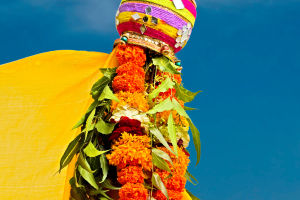As winter fades away and nature begins to awaken, Basant Panchami shines as a symbol of hope and renewal.
Also known as Vasant Panchami, this vibrant festival fills the air with joy and color.
Join us as we dive into the beauty of Basant Panchami, exploring it's cultural richness, timeless traditions, and fascinating facts that deepen it's significance.
Basant Panchami resonates across the Indian subcontinent, from the lively traditions of Punjab to the cultural vibrance of West Bengal, and the deep spirituality of Uttar Pradesh. Homes, temples, and educational institutions glow with yellow decorations, mirroring the golden fields kissed by the sun.
Basant Panchami celebrates the eternal cycle of life, reminding us of the passage of time. It honors the divine presence of Goddess Saraswati, seeking her blessings for knowledge, creativity, and clarity of thought. For farmers, it signals the beginning of the agricultural season and the promise of a fruitful harvest.
Historical Significance
Basant Panchami has ancient roots, with mentions in Vedic texts and scriptures dating back to the early days of Hindu culture. Celebrated for thousands of years, the festival has evolved, yet preserved it's deep cultural importance.
Association with Music and Arts
Basant Panchami holds special significance for musicians, artists, and scholars. It is a time when they seek the blessings of Goddess Saraswati for creative inspiration and artistic excellence, making it a day to celebrate learning and creativity.
Regional Variations
Though Basant Panchami is celebrated across India, each region adds it's unique charm to the festivities. In Punjab, it’s celebrated with energetic folk dances like Bhangra and Giddha, while in Bengal, the day is marked by the grand Saraswati Puja with intricate rituals.
Scientific Significance
Basant Panchami coincides with the sun’s transition into the zodiac sign of Aquarius (Kumbha), heralding the gradual lengthening of days and the arrival of warmer temperatures. This seasonal shift marks the beginning of spring.
Springtime Harvest Festivals
While Basant Panchami is deeply rooted in spirituality and the worship of Goddess Saraswati, it also marks the beginning of the agricultural season in many parts of India. Farmers, with hopes of a prosperous harvest, offer prayers and perform rituals to seek blessings for fertile lands and abundant crops.
This sacred occasion symbolizes the harmonious connection between humanity and nature, reflecting the age-old bond that sustains both our livelihoods and the earth’s bounty. It is a time when the entire community comes together to celebrate the nurturing power of nature, the changing seasons, and the cyclical rhythm of life that governs both the harvest and the soul.
Basant Panchami is a celebration the beauty of nature’s rhythms and the resilience of the human spirit. With it's vibrant spirit, age-old rituals, and deep symbolism, the festival highlights the triumph of light, knowledge, and the endless possibilities that spring brings. As we welcome the colors of the season and the blessings of Goddess Saraswati, let’s embrace the promise of new beginnings and the eternal renewal of life!


